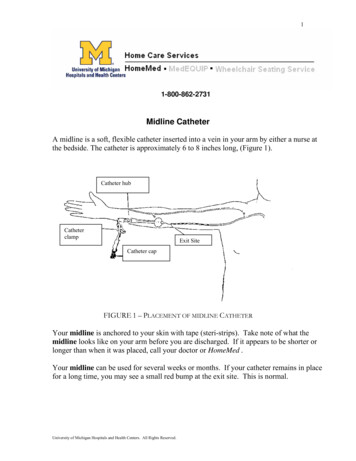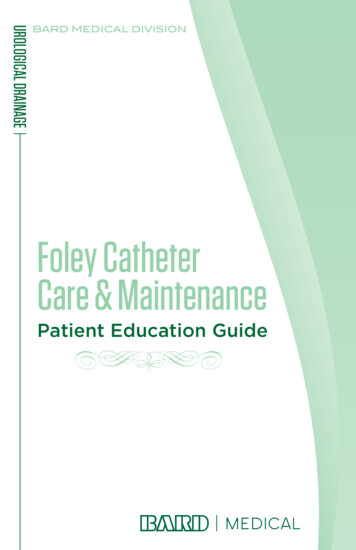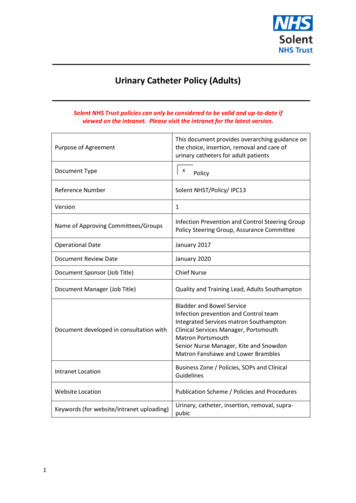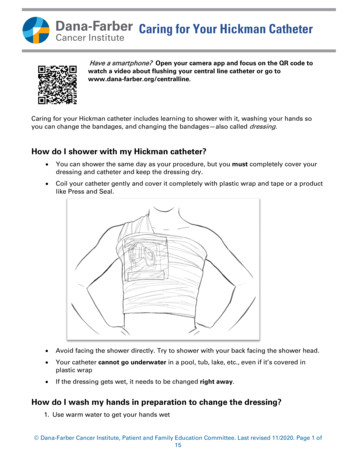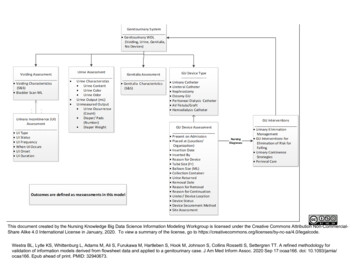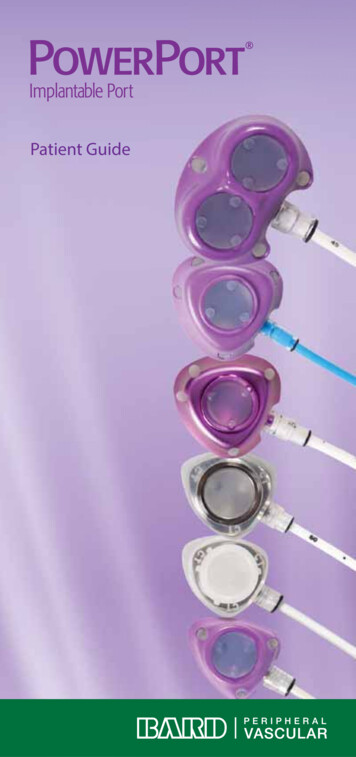![Catheter And Continence Equipment [Adults]- First Line Prescribing .](/img/23/cathetercontinenceequipment.jpg)
Transcription
Hull & East Riding Prescribing CommitteeCatheter and Continence Equipment [Adults]First Line Prescribing Formulary GuideDocument SummaryDirectorate:Medicines OptimisationDocument Purpose:To inform prescribers in Hull and ERYCCGs about the continenceformularyDocument Name:Guidance on prescribing continence appliances in primary care withinHull and ERY Clinical Commissioning GroupsDocument Ref No.Author:Andrea Murray/Julie Curran/Laura BulmerReport Owner or Sponsor:Target Audience:Julie CurranAll prescribers in Hull and the East Riding of Yorkshire CCGsSuperseded Document:N/AAction Required:To note for compliance with the procedureContact DetailsName & Title: Julie Curran(for further information and feedback)Tel: 01482 672142E-mail: julie.curran1@nhs.netDocument StatusThis is a controlled document. Whilst this document may be printed, the electronic version posted on theintranet is the controlled copy. Any printed copies of this document are not controlled.As a controlled document, this document should not be saved onto local or network drives but should always beaccessed from the intranet.Developed byBladder & Bowel Health Specialist Service(CHCP) in conjunction with the MedicineOptimisation team(NECS). Fourth AdditionApproved by HERPC: Mar 2019Review: Mar 20221
Hull & East Riding Prescribing CommitteeApproved by HERPC: Mar 2019Review: Mar 20222
Hull & East Riding Prescribing CommitteeTable of Contents1. Introduction . 41.1.Aim. 41.2.Scope of the guidance . 41.3.Key messages . 41.4.Responsibilities of the General Practice . 5References. 7Acknowledgements . 7Appendix Two: Formulary . 9Appendix Three:Abbreviations . 28Approved by HERPC: Mar 2019Review: Mar 20223
Hull & East Riding Prescribing Committee1.Introduction1.1.Aim The aim of this document is to provide guidance on issuing prescriptions forappliances to manage bladder and bowel dysfunction, to help reduce overordering, wastage, poor communication and inappropriate use.The document outlines the responsibilities of the Bladder and Bowel HealthPractitioners, GP, dispensing contractor (dispensing appliance contractor (DAC),community pharmacy and dispensing doctor) and the patient/carers or relatives.The healthcare professional (HCP) who prescribes the treatment legally assumes clinicalresponsibility for the treatment and the consequences of its use.1.2.Scope of the guidanceThis guidance is designed to be used by all prescribers, GP practices and specialistnurses.1.3.Key messages1.3.1. Responsibilities of the HCP initiating urinary catheterisationTo perform a full continence assessment.Select and initiate the most appropriate product(s) for treatment/management withoutpressure from any sponsoring company.Product selection should be made to meet the individual patient clinical needsproducts are suitable for all patients).(not allAll patients must be supplied with a Catheter Passport, the details must be completed bythe healthcare professional.If formulary products do not meet the patient’s clinical need and an alternative isrequired, liaise with Bladder and Bowel Health Practitioners for guidance. Appendix 2 provides guidance to prescribers for cost effective first line products. Itis not intended to restrict patient choice.Only continence products listed in the Drug Tariff should be initiated.Ensure the patient has an established treatment plan that they fully understand.Discuss with the patient if they would like to continue using their preferred dispenserfor continence appliances or to have their prescription sent to a DAC.Communicate promptly with the patient’s GP/DAC regarding: Product initiation (including product codes) Expected monthly usageApproved by HERPC: Mar 2019Review: Mar 20224
Hull & East Riding Prescribing Committee 1.4. Expected duration of treatment; or, if long term, date of next review. Monitor response to treatment, or advise GP of monitoring requirements.Following any change to prescription, advise both GP and dispensing contractor(where appropriate) of any modifications. This will include advising of any productsno longer required.The HCP will not request any products to be supplied via a DAC before aprescription is issued.Ensure that there are clear arrangements for back-up stock, advice and support.Ensure patients understand how and when to re-order products (GP / DAC).HCPs must remember that the risks associated with catheter usage are of a seriousnature that increasingly may become more difficult to justify.The need for urinary catheterisation must be reviewed at every catheter changeand as the patient’s circumstances change.An initial continence assessment and risk assessment should be carried out toensure that there is clinical need and that catheterisation is deemed necessary.The patient’s suitability for intermittent, supra-pubic or urethral catheterisation mustbe considered.The risks, advantages and disadvantages must be discussed with the patient priorto inserting a new catheter to ensure that they can make an informed choice.Registered nurses should not promote indwelling catheterisation to be the best oreasiest option for the patient and it must never be undertaken for nursing or carerconvenience.When an indwelling catheter is inserted a plan for early removal should be made,due to the infection risk increasing on a daily basis.Registered nurses must be aware of the serious implications and risks whenmaking the decision to catheterise a patient.Following discharge from Secondary Care, where urinary catheterisation is part ofthe treatment, this is usually temporary, patients may be readmitted for a trialwithout catheter(TOC) or arrangements made for this to be performed in thecommunity.Where chronic retention is present accompanied by a history of renaldysfunction/damage and intermittent self-catheterisation is not a viable option.Responsibilities of the General PracticeInitiate a system for supply and then continue prescribing, adjusting prescriptions forproduct(s) as advised by the specialist only. Check quantities requested against information in the Formulary; this givessuggested quantities, directions and notes to assist with prescribing. Be aware ofthe normal usage rate by the patient and ensure that any irregularities are flaggedto the GP and reviewed with the patient/carer.The prescriber will take clinical responsibility for products prescribed.Approved by HERPC: Mar 2019Review: Mar 20225
Hull & East Riding Prescribing Committee The practice should not issue retrospective prescriptions requested by thedispensing appliance contractor.oThe DAC must receive the prescription PRIOR to the delivery of items.oIf the dispensing contractor delivers item(s) prior to receiving aprescription, a prescription may not be issued to cover the supply if it isnot considered necessary/appropriate. Print the prescription for the patient/carer (or send to DAC) within the agreedturnaround time and by the agreed method of dispatch. If using Electronic Prescription Service (EPS), the patient can nominate a pharmacyfor the dispensing of medicines AND an appliance contractor for the dispensing ofcontinence appliances. Document any communication from the dispensing contractor and specialist in thepatient’s clinical record. Report to and seek advice from the Bladder & Bowel health practitioner, consultantor prescriber on any aspect of patient care that is of concern and may affecttreatment. Stop or adjust treatment/management on the advice of Bladder and BowelPractitioner or prescriber or immediately if an urgent need to stop treatment arises. Copies of the Appliance Use Review (AUR) should be reviewed by an appropriateperson in the practice and stored in the patient’s medical records. Ensure clear communication to the patient with regard to the process agreedbetween the practice and the contractor e.g. the interval prior to delivery when theregular prescription request should be submitted. When a patient dies, the practice must inform the dispensing contractor so that anyprescriptions (including repeat dispensing prescriptions) that have not yet been sentor dispensed can be retrieved and destroyed. The practice should ensure that the patient/carer:oUnderstands the treatment.oIs aware of how to raise any concerns and report any problems in relationto the treatment.oUnderstands the ordering process and reports any problems with supplyto the specialist or GP. It is strongly recommended that the practice has its own agreed protocol for how itdeals with dispensing contractors.1.4.1. Points to consider Where possible, agree a named person at the GP practice for managingprescription requests for appliances.If possible, agree a named contact with the dispensing contractor. All prescriptionrequests should come from the patient/carer, however the contractor may need tobe contacted to clarify the delivery schedule, product availability etc.Approved by HERPC: Mar 2019Review: Mar 20226
Hull & East Riding Prescribing Committee Consider frequency of supply and the turnaround time from request of prescriptionby dispensing contractor to dispatch of prescription from surgery (e.g. 48 hours).Consider method of receipt of prescription by contractor e.g. post or EPS. It isrecommended that if prescriptions are posted to contractors, a record is kept and ifpossible a certificate of posting obtained (to help with any queries regarding missingprescriptions).It is strongly recommended that requests for emergency prescriptions should onlybe accepted from the patient/carer.If there are concerns around over ordering or the first line choice listed is unsuitableplease contact your Bladder and Bowel Health Service for further advice and support on01482 347894 ERY or 01482 247111 HullResponsibilities of the patient or carer To order when they reach a defined threshold sufficient to allow time for theprocessing of the prescription. To avoid stock piling:oproducts have a recommended shelf life and are influenced by changesin temperature.oproduct choice may change over a period of time.References1. PrescQIPP2. NICE (2017) Infection; Prevention and control of healthcare-associated infections in primaryand community care; London3. Royal College of Nursing (2012) Catheter Care Guidance for nurses. London: RCN4.Pratt et Al Evidence Based Guidelines for Prevention Health Care Infections in NHSHospital in England Journal of Hospital Infection 65SS1-S645. FillinghamS, Douglasj(2005)Urological Nursing (3rd edition) Bailliere Tindall,LondonAcknowledgementsHartlepool and Stockton-on Tees (HAST) CCG Guidance on Prescribing Continence products in GeneralpracticeApproved by HERPC: Mar 2019Review: Mar 20227
Appendix One: Continence appliance prescription request algorithm for new and existing adult patientsRequest for continence product receivedNon formulary item requestedNewpatientNon formularyproduct requested –Send request back foralternative formularyitemFormulary product – check the quantityagainst formulary.ExistingpatientPrescribe non formularyproduct and request areview from the HCPwho made the requestQuantity requested isover recommendedamountFlag to GP or prescriberand request review withpatient/carerQuantity in line withformularyIssue prescription andattach request form tothe prescription ready forGP to sign.
Hull & East Riding Prescribing CommitteeAppendix Two: FormularyPrices correct as at August 2018Plain Lubricant (Check not included with catheter)OrdercodeProductOptilube 6ml syringe sterilelubricantOptilube 11ml syringe sterilelubricantUnitprice 0.91Quantity1 percatheter1 percatheter 0.96NotesstTo use 1 lineOne to be used at each catheter change.Order in singles appropriate to the number of catheters prescribed.For urethral catheter insertion 6ml female, 11ml male.Licensed for supra pubic use if requiredTo reduce risk of urethral damage, discomfort and infection.6ml for suprapubic catheterisation if requiredAnaesthetic lubricant /Lubricant (Check not included with catheter)OrdercodeProductOptilube Active CHG free 6mlsyringe sterile anaestheticlubricant with LidocaineOptilube Active CHG free 11mlsyringe sterile anaestheticlubricant with LidocaineUnitprice 1.09 1.14QuantityNotes1 perUse 2nd line to facilitate pain free insertioncatheterTo help reduce the risk of associated infectionOne to be used at each catheter change.1 percatheter Order in singles appropriate to the number of catheters prescribedLicensed for the male and female urethral catheterisationNot to be used for Supra-pubic catheterisation
Hull & East Riding Prescribing CommitteeUrinary CathetersPatient assessment, reviews and ongoing evaluation is essential to prevent catheter related problems and risks such as associated urinary tract infectionsAim to remove catheter as soon as possible following insertion if appropriateAim to use the smallest catheter size that provides adequate drainage to avoid discomfort and irritation.Select the correct length and type of catheter. Standard/male – for males/females and supra pubic catheterisation. Female length – for females only.Use 10ml balloon, use the recommended amount of sterile water required to fully inflate the balloon.Under inflation can distort the angle of the catheter tip, causing bladder spasm and bladder mucosa damageOver inflation could prevent the catheter draining effectivelyShort Term Catheters Supra pubic and urethral use. Can be left in place for a maximum of 28 days.Use if frequent blocking occurs within the 28days and cannot be resolvedPatient must not have a Latex allergyUnitGauge/CH priceOrder codeProductDP210112RuschAquaflateAll 12PTFE Coated latex foley14catheterFemale length16 2.19RuschAquaflateAll 12PTFE Coated latex foley14catheterMale / standard length16 tyNotesInitialFemaleprescription Includes empty syringe for deflation of previous catheter and afor 3 thensyringe prefilled with sterile water.One every4 weeksMaleIncludes empty syringe for deflation of previous catheter and asyringe prefilled with sterile water.
Hull & East Riding Prescribing CommitteeLong term Hydrogel coated Latex Catheters for Urethral & suprapubic use Can be used up to 12 weeksOrder codeProductGauge/CH Unit priceQuantityNotesDH310112Rusch SympacathAquaflate Hydrogel coatedlatex catheter.(Teleflex)12Initialprescriptionfor 3 thenOne every 12weeks (nolubricantsupplied)Standard /Male lengthIncludes empty syringe for deflation of previous catheter and asyringe prefilled with sterile waterInitialprescriptionfor 3 thenOne every 12weeks (nolubricantsupplied)Female OnlyIncludes empty syringe for deflation of previous catheter and asyringeprefilled with sterile water.DH310114DH310116DH210112DH21011414 6.2716RuschSympacathAquaflateHydrogel coated latex catheter(Teleflex)1214 6.27DH21011616Long Term Catheters All silicone - Urethral and Supra-pubic use. Can be used up to 12 weeksUse for patients with a Latex sensitivity or to extend life of catheter which is persistently blocked by debris or encrustationComes with Lidocaine and Chlorhexidine anaesthetic gel – ensure patient does not have a Chlorhexidine allergy. Note: a separateprescription for anaesthetic gel is NOT required
Hull & East Riding Prescribing CommitteeOrder codeProductGauge/CH Unit priceQuantityNotes08501205WFoley 2-way Round tip siliconecatheter.(L.IN.C Medical)12 5.57Initialprescriptionfor 3 thenOne every 12weeksMale / Standard lengthHave a reduced risk of balloon cuffing on deflationIncludes empty syringe for deflation, 5.57InitialPrescriptionfor 3 thenOneevery12 weeksFemale OnlyHave a reduced risk of balloon cuffing on deflationIncludes empty syringe for deflationSyringe containing sterile water for inflation.08501405W1408501610W16085012051W Foley 2-way Round tip siliconecatheter.085014051W (L.IN.C Medical)12085016101W1614Long Term Catheters All silicone - Urethral and Supra-pubic use. Can be used up to 12 weeksUse for patients with a Latex sensitivity or to extend life of catheter which is persistently blocked by debris or encrustationOrder codeProductGauge/CHPCF12M10Prosys All silicone foleycatheter(Clinisupplies)12PCF14M10PCF16M10Unit priceQuantityNotes 5.68Initialprescriptionfor 3 thenOne every12 weeks(nolubricantsupplied)Standard/ Male 10ml balloonIncludes empty syringe for deflation of previous catheter and asyringeprefilled with sterile water.Larger eyelets to promote better drainageIntegral balloon to reduce risk of cuffing1416
Hull & East Riding Prescribing CommitteePCF12F10PCF14F10Prosys All silicone foleycatheter(Clinisupplies)1214 5.68PCF16F10Initialprescriptionfor 3 thenOne every12 weeks(nolubricantsupplied)Female Only 10ml balloonIncludes empty syringe for deflation of previous catheter and asyringe prefilled with sterile water.Larger eyelets to promote better drainageIntegral balloon to reduce risk of cuffing16Long term catheter Hydrogel Coated Silicone catheter. Urethral and Supra-pubic use. Can be used up to 12 weeksUse only if the all silicone catheter causes irritation or discomfort to the clientOrder codeProductGauge/CHUnit priceQuantityNotesD175812ELubrisil Aquaflate Hydrogel coatedsilicone catheter(Bard)12 9.68Initialprescriptionfor 3 thenOne every12weeks.(nolubricantsupplied)Standard/ MaleIncludes a syringe prefilled with sterile waterThis product will require a justification form completing beforeorderingD175814ED175816E1416
Hull & East Riding Prescribing CommitteeD176112ED176114ELubrisil Aquaflate Hydrogel coatedsilicone catheter(Bard)D176116E12 9.6814Initialprescriptionfor 3 thenOne every12weeks.(nolubricantsupplied)Female onlyIncludes a syringe prefilled with sterile waterThis product will require a justification form completing beforeordering16Specialist catheters – for Urethral and suprapubic useCan help with life of catheter in cases of persistent blockageComes with Lidocaine and Chlorhexidine anaesthetic gel – ensure patient does not have a Chlorhexidine allergy. Note: a separateprescription for anaesthetic gel is NOT requiredOrder codeProductGauge/CH08451205WSupra-Flo Open tip All siliconeL. IN.C Medical1208451405W14Unit price 10.95(1)Quantity NotesStandard / maleIncludes sterile water filled syringe for balloon inflation, empty syringefor balloon
Hull & East Riding Prescribing Committee08451610W08471205W16Supra-Flo Open tip All silicone12L. IN.C Medical08471405W1408471610W16deflation and a syringe of anaesthetic lubricant containing lidocaine &chlorhexidine for lubrication - ensure patient does not have aChlorhexidine allergySizes 12 & 14CH have a 5ml balloon 10.95Female Only(1)Includes as aboveCatheter ValvesFor use with indwelling catheters only. These provide a discrete alternative to drainage bags. Their use helps to imitate normal bladder function by allowing thebladder to fill and empty, maintaining normal capacity and tone. They prevent the catheter tip touching the bladder wall reducing the risk of tissue damage :NOT suitable for patients with a reduced bladder capacity, cognitive impairment, poor manual dexterity, renal impairment or Post Radical ProstatectomyOrder codeProductUnit priceQuantityNotesCF1L.IN.C MedicalCare-Flo 7.59(5)1 box of 5 permonthCatheter valves should be changed every 5-7 days.Add as direction21104204MacGregorQufora 8.50(5)1 box of 5 per monthCatheter drainage bags – LEG BAGSLeg bags may be worn in different positions on the leg, i.e. inside thigh/calf, which is an individual choice, and this will determine the length of the inlet tube.Maintaining a closed drainage system (i.e. not removing the leg bag when attaching a night bag) reduces the risk of infection. The leg bag must remain connectedto the catheter and linked to the night bag if additional drainage capacity is required overnight. 500mls bags have been listed below, as this is the most commonsize used. Other volume leg bags are available - liaise with Bladder and Bowel Health Service if other volume bags are required
Hull & East Riding Prescribing CommitteeOrder codeProductLM500SD-LLinc-Flo Lever TapDirect inletLM500MD-LLinc-Flo Lever Tap10cm TubeLM500LD-LLinc-Flo Lever Tap30cm TubeLM500SD-TLinc-Flo T TapDirect inletLM500MD-TLinc-Flo T Tap10cm TubeLM500LD-TLinc-Flo T Tap30cm Tube12161704Qufora Q flow Lever TapDirect TubePack Sizeprice500mls x 10 22.27500ml x10Quantity Notes1 box of All the leg bags are sterile10 every10 weekL.IN.C include 1 pair of leg straps & a pair of sterile gloves with eachbagLinc-Flo Leg bags should be changed every 5-7 days,add this as a direction on the prescription 22.31No more than one box of ten should be issued alternate months (6 x10boxes per year).Orders in excess should be questioned as it is poor practice andincreases risk of infection to change more frequently than every 5-7days.(including care homes)1 box of10 every12weeks12161804Qufora sterile, Q flow Lever TapShort Tube12161504Qufora sterile, Q flow Lever TapLong Tube12151704Qufora T TapDirect inlet Tube500ml x10 22.40500ml x10 22.40Qufora include a pair of sterile gloves with each bag and 1 pair of legbag straps per box of 10 bagsQufora leg bags should be changed every 10 days –add this as a direction on the prescription(manufacturers recommendation).
Hull & East Riding Prescribing Committee12151804Qufora T TapShort inlet Tube12151504Qufora T TapLong inlet tubeNight bagsSuitable for night time use for the collection of urine from indwelling catheters or urinary sheaths. The position of the bag should be below bladder level to enhancedrainage. Night bags should be used in conjunction with a catheter stand, available from the companies (not available on FP10). Liaise with Bladder & Bowel serviceNight bags should be directly connected to the leg bag to maintain a closed system.Non-drainable night bags are the preferred option as single use reduces the risk of infection.A 3L bag is available for patients with a high night time diuresis, liaise with Bladder & Bowel Service PractitionersOrder codeProductLM2LNSNon-sterile 2litre night bag(L.IN.C medical)PSU2Prosys Non- sterile 2 litrenight bag(Clinisupplies)PackSizeUnit priceQuantityNotes10 perpack 2.13 perpack3 packs per month Single use. Drainable night bag with 100cm inlet tube and non-returnvalve. Tear off drainable tap10 perpack 3.06 perpack3 packs per month Single use drainable night bagT tapCatheter accessories – Fixation devicesIt is extremely important that both the catheter and the leg bag is well supported to reduce traction and trauma to the bladder neck/urethra and bladder wallOrder codeProductFIX Strip(L.IN.C medical )Pack SizeAdjustableUp to100cms(4)Unit priceQuantityUse 9.951 pack of 4 The catheter strap is used as a retaining strap which secures the tubing orevery 4 to 6 catheter firmly and comfortably against the leg to prevent tissue damagemonthsand traction trauma(including
Hull & East Riding Prescribing Committeecare homes)L.IN.C medical straps include a pair of scissors to cut the strap to sizeLarger sizes are available, if requiredThese are washable and reusableFor the fixation of indwelling catheters, Fixation devices must be used toprevent traction trauma and tissue damageAdhesive with retainer to secure catheter in place – change every sevendaysCan be removed and repositionedAdhesive fixation devise to secure catheter in place – change every 7 days3002UGO fix catheter strapShortUp to 45cm(x5) 12.683003UGO fix catheter StrapMediumUpt o 80cm(x5) 14.003004Ugo Fix Gentle1 box of 5 12.531 box everymonth40-310Clinimed Clinifix tube holderSmallBox of 10 17.691 box every10 week40-410Clinimed Clinifix tube holderMediumBox of 10 19.341 box every10 weekAdhesive fixation devise to secure catheter in place – change every 7 daysFOL0102DTBard StatlockBox of 5 12.911 box everymonthAdhesive fixation devise to secure catheter in place – change every 7 daysNot to be used on friable skinOrder codeProductPack SizeUnit priceQuantityUsePLS3881Clinisupplies Prosyssleeve smallClinisupplies Prosyssleeve Medium24cm-40cm 7.55 perpack of 4 7.55 perpack of 4One Pack of4 should lastfor 4 to 6months(includingcare homes)Clinisupplies Prosyssleeve Large40cm-65cmUsed to support leg bags attached to Indwelling catheters and urinarysheath systems.The leg bag sleeve can be used as an alternative to leg bag straps.Particularly if the patient has fragile skin, or problems with straps digginginto or rubbing against the leg.The patients leg must be measured to ensure the correct size sleeve isprescribedPLS3904PLS392836cm-50cm 7.55 perpack of 4
Hull & East Riding Prescribing Committee3007Ugo Fix sleeve Extra large65cm-90cm 7.39 perpack of 4Prosys sleeves are washable for 30 washes.Catheter maintenance solutions (CMS)Must not be prescribed for routine use, catheter change should be performed rather than a solution being used on a regular basis (NICE 2012)Catheter Maintenance solutions should NOT be used to prevent infection (NICE 2016)CMS should NOT be used to unblock catheters (RCN 2012)CMS are not recommended for routine catheter care, catheter blockage or bypassing. Reason for catheter blockage must always be established and documentedAll other treatment options should be tried in the first instance. If unsure discuss with Bladder and Bowel Health PractitionersCMS must not be instilled into the bladder with force or clamped and retained for any longer than 5mins .CMS poses a risk of catheter associated UTI (CAUTI). Therefore if used, an antiseptic non-touch technique (ANTT) procedure must be followed and the use of CMSlimitedFirst check for mechanical reasons for blockage i.e kinked/obstructive tubing/constipation and actionIf used there must be a clear rational for use documented and they must be evaluated at every catheter changeCHCP have a patient group directive for CMS use (saline 0.9% flush) for blood clot retention onlyIntermittent catheters (ISC) These are suitable for patients with incomplete bladder emptying e.g. neurogenic bladder disorders, particularly patients with multiple sclerosis, spina bifida,diabetes and spinal cord injury. Patient needs good dexterity and cognitive ability. These catheters are for single use only. . Help to reduce catheter-associated urinary tract infections (CAUTI) – classed as Gold standard by NICE. How many a patient uses a day depends on their medical reason & post void residual amount. Use can range from 1 to a usually maximum of 7 times daily.Refer / liaise with Bladder and Bowel Health Practitioners regarding over use. All patients should be managed by the Bladder and Bowel Health Service team.The below products may not be suitable for all patients therefore the Bladder and Bowel Practitioners will request the most suitable alternative product forthe patient and justify the reasonOrdercodeProductGauge/C Unit priceHNotes
Hull & East Riding Prescribing CommitteeFemale length catheters 44.31Box of 309cm Pre-lubricated with glycerine for smooth insertion and removalQuantity supplied to the patient needs to be stipulated by the clinician at the start of treatment.10 39.0014cm Hydrophilic catheter with integrated water sachet12Box of 30Quantity supplied to the patient needs to be stipulated by the clinician at the start of treatment. 42.39Per pack of 309.5cm Gel compartment to provide smooth coating with no mess 47.10Per pack of 307cm lengthLow friction catheter in saline with easy-grip handleQuantity supplied to the patient needs to be stipulated by the clinician at the start of treatment.228010E10228012E Actreen Mini Female(B.Braun Medica)l228014E12WHF10WHF12Curan AvantageLady(CliniMed)WHF14CL101414Curan Lady thCompact (Coloplast)122858414416102510LoFric Sense(Wellspect4161425 HealthCare)416122512 48.1214per pack of 30Quantity supplied to the patient needs to be stipulated by the clinician at the start of treatment.10 cm lengthLow friction catheter in saline with easy-grip handleQuantity supplied to the patient needs to be stipulated by the clinician at the start of treatment.Female length closed drainage Intermittent Catheters with integral collection bag
Hull & East Riding Prescribing Committee239010E Actreen Mini SetFemale239012E(B.Braun Medical239014E12226310E10226312EActreen Glys set226314E(B’Braun)10 70Box of 309cm Pre-lubricated with glycerine for smooth insertion and removalClosed drainage system with a 750ml drainage bag, Used for patients with poor balanceQuantity supplied to the patient needs to be stipulated by the clinician at the start of treatment.141214 62.7025cm lengthGlycerine coated catheter with 1litre integral bag (closed drainage system)Closed drainage system which must be used if a healthcare professional is performingIntermittent catheterisation on a patientPer box of 30Quantity supplied to the patient needs to be stipulated by the clinician at the start of treatment423102520cm length Hydrophilic catheter with salt solution10Lofric Hydrokit(Wellspect)Non-touch technique promotes hygieneLoops are easy to use, even with poor hand function The quantity supplied to the patient needsto be stipulated by the clinician at the start of treatment.423122512423142514Intermittent catheters (ISC)UNISEX lengthWHU10
catheter To use 1st line One to be used at each catheter change. Order in singles appropriate to the number of catheters prescribed. For urethral catheter insertion 6ml female, 11ml male. Licensed for supra pubic use if required To reduce risk of urethral damage, discomfort and infection. 6ml for suprapubic catheterisation if required

